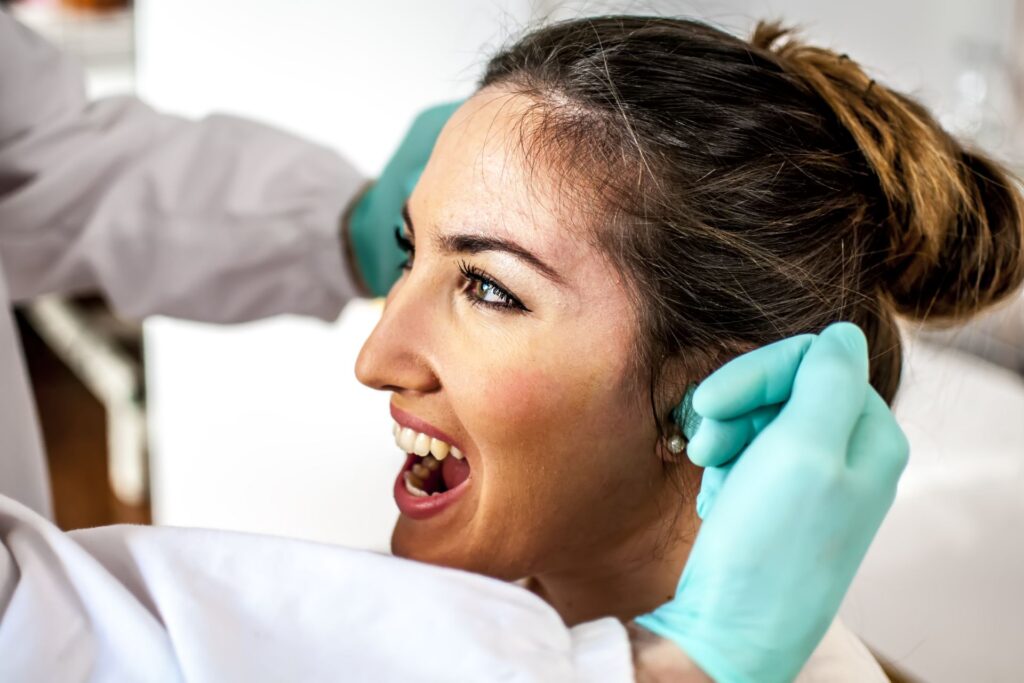What is the best treatment for TMJ (Temporal Mandibular Joint)/ Jaw Pain?

TMJ (Temporal Mandibular Joint) / Jaw Pain is very common around us but it was hard to be treated well due to limited knowledge of this particular joint.
I am going to share some useful information about its mechanism and treatment method.

What Causes TMJ / Jaw Pain?
- Injuries to the jaw area
- Dental procedures (even prolonged mouth opening)
- Teeth clenching and grinding during sleep or while doing strenuous activities
- Stress, anxiety, and emotional distress
- Tight muscles in the jaw (Masseter, Pterygoid muscles)
- Hurtful foods and habits
- Sleep disorder, disruption, or deficiency
Symptoms of TMJ Disorders
- Pain, discomfort or stiffness in the jaw muscles
- Difficulty in opening or closing the jaw with clicking sound
- Jaw is not opening evenly making ‘s’ or ‘c’ movement
- Pain in the neck and shoulders
- Chronic headaches
- Limited movement or locking of the jaw
- Ear pain, pressure, fullness, ringing in the ears (tinnitus)

Why bad posture makes TMJ (Jaw) pain worse?
Slouched posture comes together with forward head posture and protruded chin position.
When your head is positioned forward, muscles in your neck and shoulder get tight since these muscles need to work more by pulling your head back.
Also, this forward head posture pulls your jaw (Mandible bone) backward.
While opening your jaw, mandible (lower part of jaw) has to move forward in the later stage.
Mouth opening can be limited since mandible is being pulled by shortened muscles.
WHAT IS MOST EFFECTIVE TREATMENT FOR TMJ (JAW) PAIN?

By Kevjonesin [CC BY-SA 3.0 (https://creativecommons.org/licenses/by-sa/3.0)], from Wikimedia Commons
TPR (Trigger Point Release) in Masseter, Pterygoid and Temporalis muscles
Trigger point is an over activated muscle knot in the muscle fiber. By releasing the trigger point in these three muscles (Masseter, Medial/Lateral Pterygoid and Temporalis muscles), we can decrease pain and tension in the TMJ joint significantly. TMR (Trigger point release) has a neurologic effect calming down the irritated muscle.
In order to perform TPR, the provider needs to approach from the inside of the mouth since the trigger point of these muscles can be palpated and released better.

Habitual Correction and Biofeeback
The most important strategy to decrease TMJ pain is to lower the chance of clenching the jaw and teeth.
Usually people clench their teeth while doing strenuous work, high intensity workout or under the stress. So, making the environment less stressful, doing mild to moderate intensity exercise program and learning proper technique to relax jaw muscles can be helpful.
Grinding or clenching the teeth while sleeping can increase TMJ pain. It gets worse when you feel exhausted. So, taking a warm shower before sleep or using proper mattress can decrease the symptom. Night splint can also be a good assistive device to decrease the chance of grinding or clenching. In addition, sleeping on your back can prevent aggravation of TMJ pain by avoiding compression force on your jaw.
Proper Jaw (TMJ) Positioning Technique
Put your lips together and teeth apart slightly with placing your tongue on the roof of palate right behind the incisors. And then, try to relax your jaw muscles as much as possible. Try this method in your daily life. You can feel relaxation on your jaw muscles.

Self Biofeedback Exercise to decrease TMJ pain
Cut and roll the paper. Hold it between the upper incisors and lower incisors.
Slightly touch your teeth on the rolled paper but try not to put any pressure on it.
If your masseter muscle is over activated, you would find difficulty doing this task.
Try to send a signal to your masseter muscles to relax more.
Once you get used to it, roll the paper side to side while holding it without any compression.
TMJ (Jaw) Exercise Program

1. Jaw deviation
Slightly deviate your jaw to the right/ Left while resisting it with your hand.
Gently hold it 3 seconds and slowly release the muscle up to the mid-line with the same hand resistance. Try 2 sets of 10 repetitions either side.
This is called eccentric exercise through which high muscle tone can be normalized.
2. Jaw (TMJ) protrusion
Slightly open your mouth
Place your fingers and resist the lower jaw while protruding it.
Hold it for 2 seconds and slowly bring it back by releasing the jaw muscle with the same hand resistance. Try 2 sets of 10 repetitions.
Try to move your jaw evenly without deviation.
3. Jaw closing with resistance
Open your jaw until you feel comfortable.
Place your fingers on lower jaw in order to resist mouth closing.
Very gently resisting each other for 8 seconds.
Try 2 sets or 10 repetitions.

4. Jaw strengthening exercise with a device
we can strengthen the jaw muscles with a special device.
We can improve muscle balance as well as strength with this exercise.
3 sets of 10 times twice in a day.
TMJ Treatment Program Protocol
1-4 sessions
TPR (Trigger point release) in the main muscles to decrease pain and increase range of motion
Apply Manual Therapy for Upper Neck and TMJ joint release
Begin posture correction program
Begin HEP (Home exercise program) to carry over the treatment effect
Learn TMJ muscle relaxation technique and apply in a daily life
5-10 sessions
Apply Manual Therapy technique to improve quality of movement
Improve core stability around neck and TMJ joint with exercise program
Progress the posture correction program and HEP to the higher level
Improve body awareness and self-management skill for a long term effect
